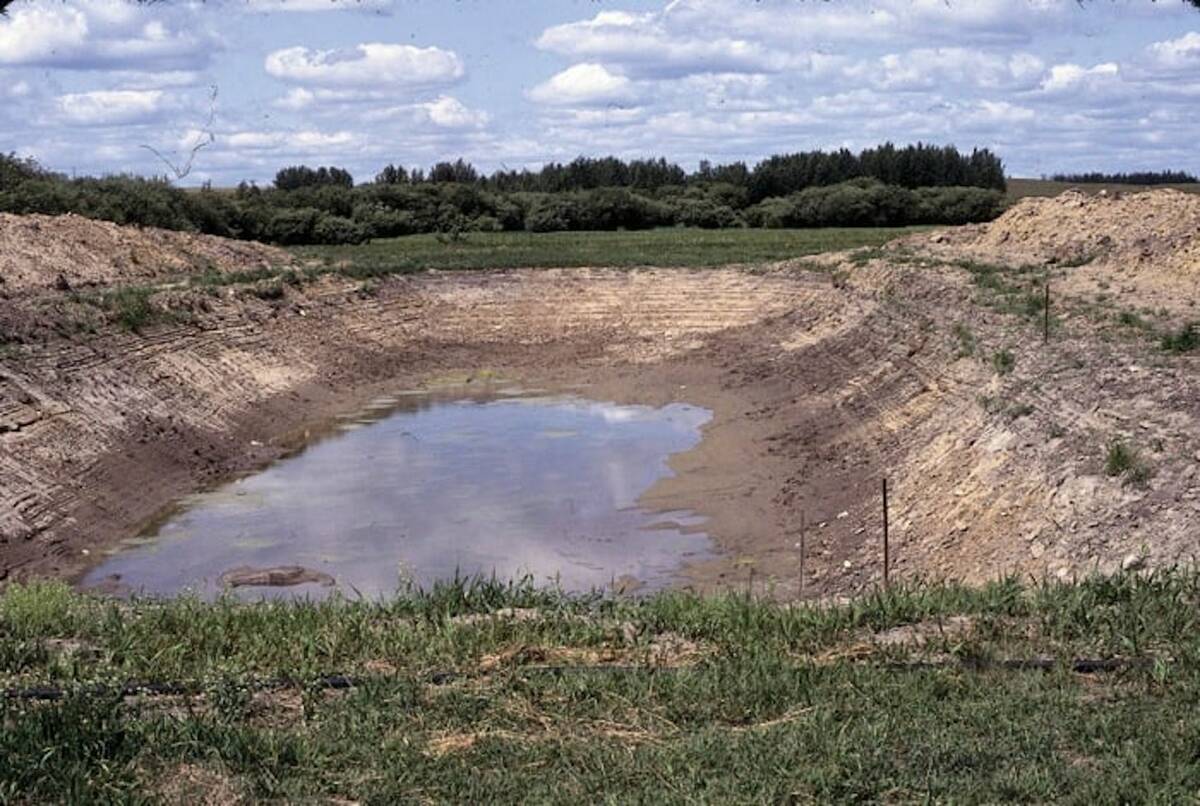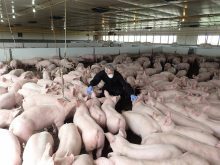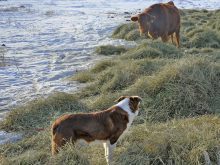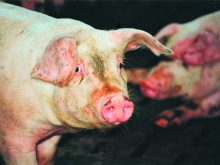African swine fever is a highly contagious hemorrhagic viral disease in pigs with a mortality that can reach 100 percent on a farm and can spread rapidly.
Infected pigs may not show symptoms before they die, making transmission even more dangerous and costly. Symptoms include fever, diarrhea, vomiting, blotchy skin, loss of appetite, weakness, coughing and difficulty breathing.
It is caused by the Asfarviridae family of viruses, which consist of one genus containing the African swine fever virus (ASFV). The virus consists of a large double-stranded DNA genome, and it can be transmitted by soft ticks or spread by contact with infected animal fluids or through contact with farm equipment, feed or clothing. There is no effective vaccine.
Read Also

Dry summer conditions can lead to poor water quality for livestock
Drought conditions in the Prairies has led to an decrease in water quality, and producers are being advised to closely monitor water quality for their animals.
According to the World Organization for Animal Health, ASFV has been reported in 32 countries on the African continent since 2005. It appeared in Eastern Europe in 2007, the European Union in 2014, China in 2018 and had spread to neighbouring 16 Asian countries by 2021.
It reappeared in the Americas after a 40-year absence in 2021, showing up in the Dominican Republic and Haiti, resulting in an urgent need to better understand the dissemination pathways of the virus.
With the threat of its persistent global spread, researchers at North Carolina State University used computer modelling to understand how ASF could spread among pig farms in the southeastern United States in the event of an outbreak and evaluate mitigation strategies.
“In our scenarios, we looked at timelines such as a 60-day snapshot,” said Gustavo Machado, assistant professor of population health and pathobiology.
“If we were that far behind following the onset of an outbreak, then we are looking at a lot of farms. But with the surveillance systems in place, we should be able to detect the disease much earlier. If we can get within the first incubation period in 12 days, we should be able to contain it quite quickly. But if we get 60 days behind, it would take us more than 4.5 months to stamp out an epidemic.”
The researchers used an epidemiological model called PigSpread to explore the different ways an outbreak could unfold. PigSpread is a farm-level, spatially explicit, transmission model of random variables to better understand the possible pathways of a threatening virus.
The PigSpread model looked at farm location and six transmission routes including between-farm swine movement, vehicles moving pigs from farm to farm, vehicles moving pigs from farms to slaughterhouses, vehicles moving crews from farm to farm, vehicles delivering feed and local spread including contaminated equipment, farm machinery, clothing and footwear.
Included in local spread was the possibility of wildlife infection through contamination in farm fields.
“If ASF gets into wildlife, then it is a huge problem,” said Machado. “Wild boars got infected in Germany last year. It’s hard to contain if it spills into wildlife populations. You have to have a national plan to eradicate it. They have been looking at that. But typically, countries that got wildlife infected struggle for a very long time.”
According to the news release, the infection data used in PigSpread came from the Morrison Swine Health Monitoring Project based at the University of Minnesota. It amasses data to build on the ability of the swine industry to improve its detection and response to emerging pathogens.
The information used in PigSpread was from 2,294 swine farms in the southeastern U.S. The researchers simulated the course of infection both with and without control strategies and varied the starting point of the outbreak. In total, they ran 230,000 different simulations with each simulation occurring over a 140-day period. They then averaged the results.
“The number of simulations might seem to be a lot, but we feel we should have done more,” said Machado. “We are trying to do more right now. We demonstrated that about 71 percent of transmissions are accounted for when animals are driven between farms. Local spread and vehicle transmission both contributed about 14 percent each.”
Machado wrote in the report that the study showed an introduction of ASF into the southeastern U.S. might cause 72 infected farms in the first two months, predominantly driven by between-farm movements of pigs. The average number of secondary infections during the first 60 days of the simulated outbreak was 49 finisher farms, 17 nursery farms, five sow farms and less than one farm in other production types.
The impact of local spread and the general movement of vehicles for farm work contributed significantly to ASF contamination, resulting in a long-distance spread of the pathogen over a range of 474 km.
However, the modelling showed that control and mitigation actions were significant. Control actions such as a combination of quarantine, depopulation of direct contacts, 72-hour movement standstill, contact tracing, both direct (swine movements) and indirect (vehicle movements), and implementation of control and surveillance zones including diagnostic testing and movement permits had significant impacts.
In the simulations where all these actions were implemented, secondary infections were reduced by up to 79 percent on average within the 140-day time frame.
The news release stated that 29 percent of the simulations where all control strategies were put into effect saw no more affected farms within that time period. Implementing the control actions led to a median of 495,619 depopulated animals, 357,789 diagnostic tests and 54,522 movement permits.
The research team has been working on PigSpread for four years. Members are in frequent touch with pig farmers and they have a standardized secure pork supply-enhanced biosecurity plan called The Rapid Access Biosecurity app in use by 15 state animal health official agencies and departments. This allows tracking of up-to-date data so farmers will have the necessary information for intervention to stamp out a possible pathogen outbreak.
Machado was quick to praise Canada for its PigTRACE program.
“Canada has a huge advantage compared to the U.S. because of how you keep track of data,” he said. “You have a project called PigTRACE. You have had this for a number of years now. It’s one of the most important tools to have in place.”
PigTRACE is an industry-led, animal traceability program requiring all premise-to-premise pig movements be recorded. The requirement is a mandatory bylaw through the federal Health of Animals Regulations and enforced by the Canadian Food Inspection Agency.
“In the U.S., the between-state movements of pigs require an eCVI (movement paperwork) that is issued by the department of agriculture of each state,” said Machado. “The white state line movements do not require such permission from the state department of agriculture.”
He said that, while the results from PigSpread are promising, they are still a bit optimistic. While the model shows that the policies in place would have an overall positive effect in the event of an outbreak, more research is required to determine what is needed to get it fully under control. Even with all the interventions, he thinks an epidemic would likely last longer than 140 days.
Machado will be speaking at the 2023 Western Canadian Association of Swine Veterinarians Conference in Saskatoon Oct. 19-20.
The report was published in the journal Preventive Veterinary Medicine.

















